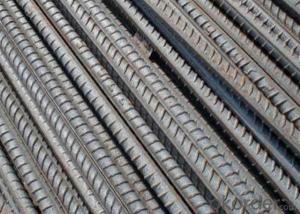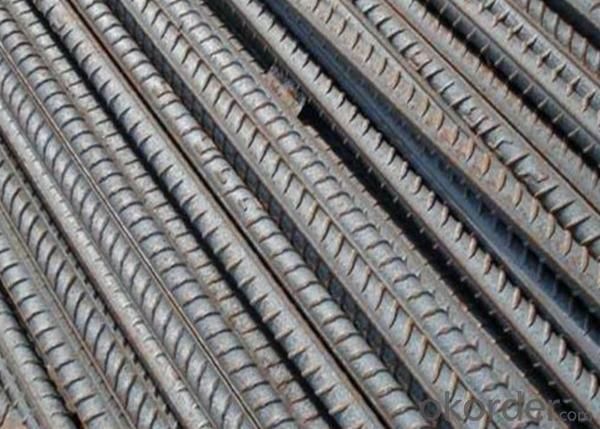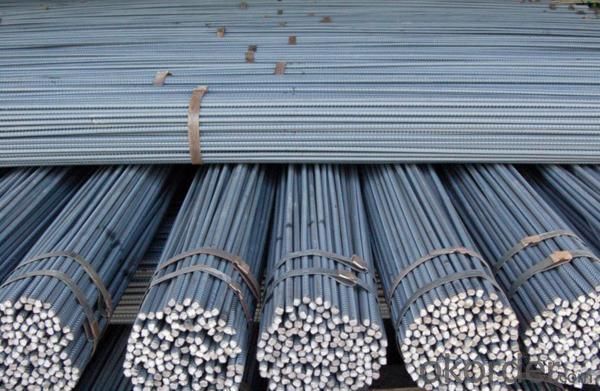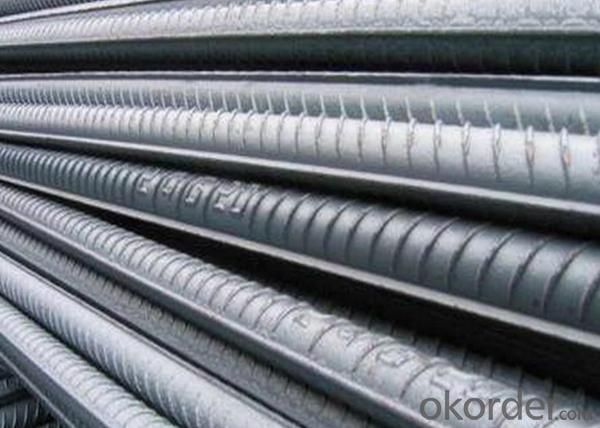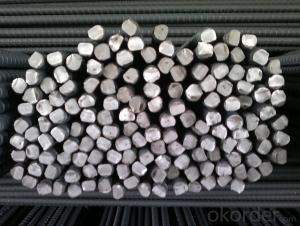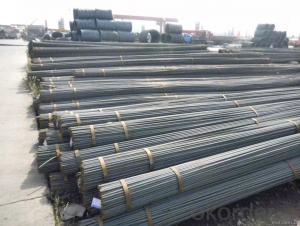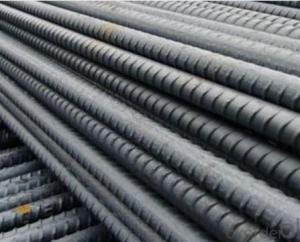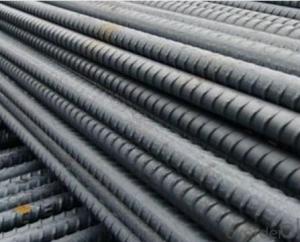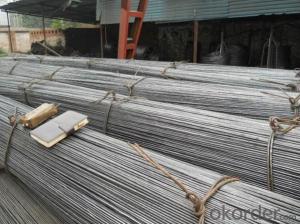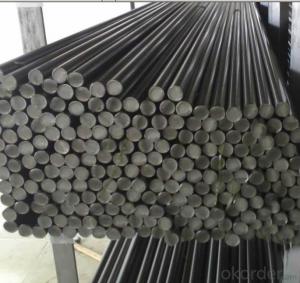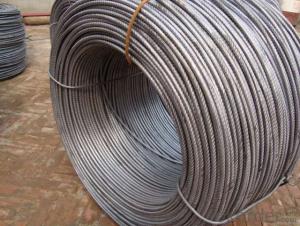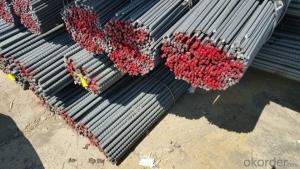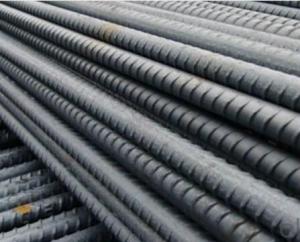Hot Rolled Steel Deformed Bar HRB400 HRB500 HRB600 for construction
- Loading Port:
- Tianjin
- Payment Terms:
- TT or LC
- Min Order Qty:
- 1000 m.t.
- Supply Capability:
- 10000 m.t./month
OKorder Service Pledge
OKorder Financial Service
You Might Also Like
Product Description:
OKorder is offering Hot Rolled Steel Deformed Bar HRB400 HRB500 HRB600 for construction at great prices with worldwide shipping. Our supplier is a world-class manufacturer of steel, with our products utilized the world over. OKorder annually supplies products to European, North American and Asian markets. We provide quotations within 24 hours of receiving an inquiry and guarantee competitive prices.
Product Applications:
Hot Rolled Steel Deformed Bar HRB400 HRB500 HRB600 for construction are ideal for structural applications and are widely used in the construction of buildings and bridges, and the manufacturing, petrochemical, and transportation industries.
Product Advantages:
OKorder's Hot Rolled Steel Deformed Bar HRB400 HRB500 HRB600 for construction are durable, strong, and resist corrosion.
Main Product Features:
· Premium quality
· Prompt delivery & seaworthy packing (30 days after receiving deposit)
· Corrosion resistance
· Can be recycled and reused
· Mill test certification
· Professional Service
· Competitive pricing
Product Specifications:
Standard | GB | HRB400 | |
Diameter | 6mm,8mm,10mm,12mm,14mm,16mm,18mm,20mm, 22mm,25mm,28mm,32mm,36mm,40mm,50mm | ||
Length | 6M, 9M,12M or as required | ||
Place of origin | Hebei, China mainland | ||
Advantages | exact size, regular package, chemical and mechanical properties are stable. | ||
Type | Hot rolled deformed steel bar | ||
Brand name | DRAGON | ||
Packaging & Delivery of Hot Rolled d-bar Steel
1. Packing: it is nude packed in bundles by steel wire rod
2. Bundle weight: not more than 3.5MT for bulk vessel; less than 3 MT for container load
3. Marks:
Color marking: There will be color marking on both end of the bundle for the cargo delivered by bulk vessel. That makes it easily to distinguish at the destination port.
Tag mark: there will be tag mark tied up on the bundles. The information usually including supplier logo and name, product name, made in China, shipping marks and other information request by the customer.
If loading by container the marking is not needed, but we will prepare it as customer request.
4. Transportation: the goods are delivered by truck from mill to loading port, the maximum quantity can be loaded is around 40MTs by each truck. If the order quantity cannot reach the full truck loaded, the transportation cost per ton will be little higher than full load.
5. Delivered by container or bulk vessel
FAQ:
Q1: Why buy Materials & Equipment from OKorder.com?
A1: All products offered byOKorder.com are carefully selected from China's most reliable manufacturing enterprises. Through its ISO certifications, OKorder.com adheres to the highest standards and a commitment to supply chain safety and customer satisfaction.
Q2: How do we guarantee the quality of our products?
A2: We have established an advanced quality management system which conducts strict quality tests at every step, from raw materials to the final product. At the same time, we provide extensive follow-up service assurances as required.
Q3: How soon can we receive the product after purchase?
A3: Within three days of placing an order, we will begin production. The specific shipping date is dependent upon international and government factors, but is typically 7 to 10 workdays.
Q4: What makes stainless steel stainless?
A4: Stainless steel must contain at least 10.5 % chromium. It is this element that reacts with the oxygen in the air to form a complex chrome-oxide surface layer that is invisible but strong enough to prevent further oxygen from "staining" (rusting) the surface. Higher levels of chromium and the addition of other alloying elements such as nickel and molybdenum enhance this surface layer and improve the corrosion resistance of the stainless material.
Q5: Can stainless steel rust?
A5: Stainless does not "rust" as you think of regular steel rusting with a red oxide on the surface that flakes off. If you see red rust it is probably due to some iron particles that have contaminated the surface of the stainless steel and it is these iron particles that are rusting. Look at the source of the rusting and see if you can remove it from the surface.
Images:
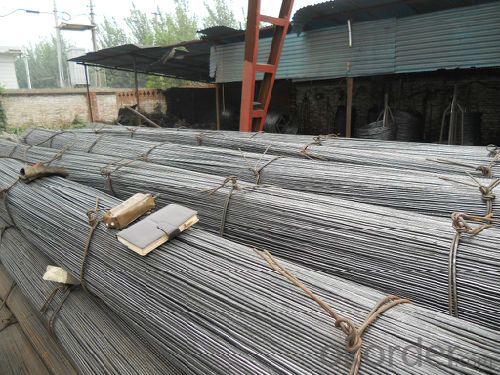
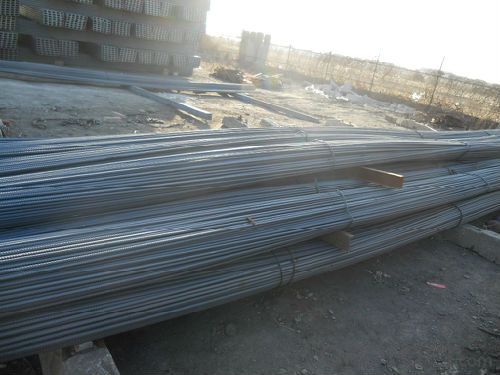
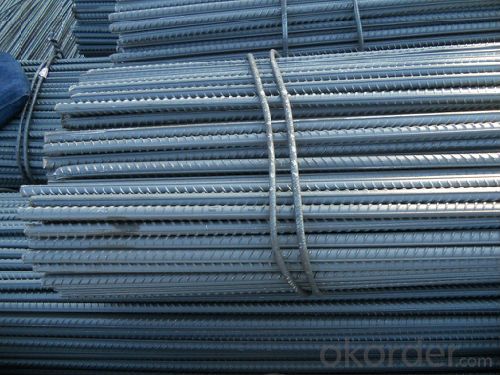
- Q: What is the role of steel rebars in preventing cracks in concrete?
- The role of steel rebars in preventing cracks in concrete is to provide reinforcement and strength to the structure. As concrete is strong in compression but weak in tension, the addition of steel rebars helps to distribute the tensile forces and resist cracking. The rebars act as a framework within the concrete, absorbing and dispersing the tension caused by external forces, such as loads or temperature changes. This reinforcement helps to increase the overall durability and structural integrity of the concrete, reducing the likelihood of cracks forming and ensuring the longevity of the construction.
- Q: Can steel rebars be used in composite construction systems?
- Yes, steel rebars can be used in composite construction systems. Composite construction refers to the combination of different materials, typically concrete and steel, to create a stronger and more efficient structure. Steel rebars are commonly used as reinforcement in concrete structures, providing added strength and durability. In a composite construction system, steel rebars are embedded within the concrete, creating a bond between the two materials. This combination allows for the utilization of the compressive strength of concrete and the tensile strength of steel, resulting in a highly efficient and resilient structure. The use of steel rebars in composite construction systems offers several benefits. Firstly, it enhances the structural integrity of the construction by increasing its load-bearing capacity and resistance to external forces such as earthquakes or heavy loads. Additionally, steel rebars help to control cracking and improve the overall durability of the structure. Furthermore, steel rebars offer flexibility in design and construction. They can be easily shaped and placed according to the specific requirements of the structure, allowing for complex and intricate designs. Moreover, steel rebars can be prefabricated off-site, making the construction process more efficient and time-effective. In conclusion, steel rebars are a crucial component of composite construction systems. Their usage in combination with concrete provides numerous advantages, including increased strength, durability, and flexibility.
- Q: What are the common problems associated with steel rebars in concrete structures?
- Some common problems associated with steel rebars in concrete structures include corrosion, inadequate cover, improper placement, and improper anchorage. One of the most significant issues is corrosion. Steel rebars are susceptible to corrosion when exposed to moisture and oxygen, especially in harsh environments such as coastal areas or regions with high humidity. Corrosion can weaken the rebars, leading to structural deterioration and reduced load-bearing capacity of the concrete structure. Another problem is inadequate cover, which refers to insufficient concrete cover over the rebars. Inadequate cover can occur due to poor construction practices or design errors. When rebars are not adequately covered, they are more prone to corrosion as they are exposed to external elements. Additionally, inadequate cover can compromise the structural integrity of the concrete, especially in terms of fire resistance and durability. Improper placement of rebars can also cause problems in concrete structures. If rebars are not properly aligned or spaced according to the design specifications, it can result in weak sections within the concrete. This can lead to uneven load distribution and potential structural failure. Improper placement can also hinder the effectiveness of rebars in reinforcing the concrete, compromising the overall strength of the structure. Improper anchorage of rebars is another common problem. Adequate anchorage is crucial to ensure that the rebars effectively transfer the load between different sections of the concrete structure. If the rebars are not properly anchored, they may slip or pull out under stress, reducing the structural strength and stability of the concrete. To mitigate these problems, it is essential to follow proper construction practices and adhere to design specifications. This includes ensuring proper concrete cover, correct placement and alignment of rebars, adequate anchorage, and using corrosion-resistant rebars or protective coatings in corrosive environments. Regular inspections and maintenance are also necessary to detect and address any potential issues with steel rebars in concrete structures.
- Q: What is the effect of carbonation on steel rebars?
- The effect of carbonation on steel rebars is primarily detrimental. Carbonation refers to the process in which carbon dioxide from the atmosphere reacts with the alkaline compounds in concrete, lowering its pH level. This reduction in pH causes a gradual decrease in the passivation layer of steel rebars, which is a protective layer that prevents corrosion. When the passivation layer is compromised due to carbonation, the steel rebars become more susceptible to corrosion. Carbon dioxide reacts with moisture in the concrete, producing carbonic acid, which further lowers the pH level and accelerates the corrosion process. As corrosion progresses, the steel rebars can lose their structural integrity, compromising the overall strength and durability of the concrete structure. The expansion of corrosion products can also exert pressure on the surrounding concrete, leading to cracking and spalling. This can expose the steel rebars to more moisture and oxygen, exacerbating the corrosion process. Furthermore, carbonation can also reduce the effectiveness of any protective coatings applied on the rebars, making them even more vulnerable to corrosion. To mitigate the effects of carbonation on steel rebars, several preventive measures can be taken. These include using concrete with a lower permeability to carbon dioxide, ensuring proper concrete cover thickness, and using corrosion-resistant steel with a higher level of chromium and/or other alloying elements. Regular monitoring and maintenance of the concrete structures are also essential to detect and address any signs of corrosion at an early stage. In summary, carbonation can have a detrimental effect on steel rebars by compromising the passivation layer, leading to corrosion and weakening of the structure. Therefore, it is crucial to implement preventive measures and regular maintenance to ensure the long-term durability and safety of steel-reinforced concrete structures.
- Q: What are the common applications of steel rebars in construction?
- Steel rebars are commonly used in construction for reinforcement purposes. They are primarily used in reinforced concrete structures such as foundations, beams, columns, and slabs to enhance their structural integrity and strength. Rebars help to resist tension forces, prevent cracking, and improve the overall durability of the concrete.
- Q: What is the impact of steel rebars on the constructability of a project?
- Steel rebars have a significant impact on the constructability of a project. They provide strength and stability to reinforced concrete structures, enhancing their durability and load-bearing capacity. By reinforcing concrete, steel rebars enable the construction of taller and more complex structures. Additionally, rebars also facilitate efficient construction processes, such as faster concrete pouring and reduced formwork requirements. Overall, the presence of steel rebars greatly improves the constructability and long-term performance of a project.
- Q: How do steel rebars affect the overall corrosion resistance of marine structures?
- Steel rebars can significantly impact the corrosion resistance of marine structures. By reinforcing the concrete, rebars enhance the structural integrity of the marine structures. Additionally, when properly coated and protected, rebars can act as a sacrificial anode, diverting corrosion away from the main structure and extending its lifespan. However, if rebars are not adequately protected or if corrosion starts, it can lead to concrete cracking and spalling, compromising the overall durability and safety of the marine structure.
- Q: What is the role of steel rebars in minimizing creep deformation in concrete?
- Steel rebars play a crucial role in minimizing creep deformation in concrete structures. Creep deformation refers to the gradual and permanent deformation that occurs in concrete over time under sustained loads. This phenomenon can lead to structural instability and compromise the overall integrity of the concrete. Steel rebars, also known as reinforcement bars, are embedded within the concrete matrix to provide additional strength and stiffness. These rebars help counteract the tensile forces exerted on the concrete, as concrete is weak in tension but strong in compression. By resisting the tensile stresses, the rebars prevent the concrete from cracking and experiencing excessive creep deformation. The presence of steel rebars in concrete also improves the load-carrying capacity of the structure, allowing it to bear heavier loads without excessive deformation. This is achieved by distributing the applied load more evenly throughout the concrete, reducing localized stress concentrations and minimizing the potential for creep deformation. Furthermore, steel rebars act as a restraining element, limiting the movement of the concrete and reducing the potential for creep. The high modulus of elasticity and low thermal expansion coefficient of steel make it an ideal material for reinforcing concrete and restraining its creep behavior. In summary, the role of steel rebars in minimizing creep deformation in concrete is multi-fold. They provide additional strength and stiffness to counteract tensile forces, improve load-carrying capacity, and act as a restraining element, all of which contribute to maintaining the structural integrity of the concrete over time.
- Q: What are the common defects found in steel rebars?
- Steel rebars can exhibit several common defects. One such defect is surface cracks, which may arise from either the manufacturing process or mishandling and inadequate storage. These cracks have the potential to compromise the rebars' strength and integrity, thereby increasing the risk of failure under load. Another frequently encountered defect is corrosion, which occurs when rebars are exposed to moisture or chemicals. This corrosion weakens the rebars and diminishes their load-bearing capacity, rendering them more susceptible to failure. Bending and straightening defects are also commonly observed in steel rebars. Improper bending or straightening techniques can result in cracks, buckling, or uneven distribution of stress, thereby compromising the performance of the rebars. Inadequate welding or improper lapping of rebars can lead to subpar connections and reduced structural integrity. Welding defects, such as lack of fusion, incomplete penetration, or excessive porosity, weaken the rebars and heighten the risk of failure. Dimensional defects, encompassing variations in diameter, length, or straightness, can impact the fit and compatibility of rebars with other structural components. When rebars are not correctly aligned or fail to meet the required dimensions, it can lead to diminished structural strength and compromised performance. Lastly, improper heat treatment during the manufacturing process can result in internal defects like segregation, inclusions, or improper grain structure. These defects undermine the rebars' strength and render them more susceptible to fracture or failure under load. In summary, it is crucial to thoroughly inspect steel rebars for these common defects to ensure the structural integrity and safety of the construction projects in which they are employed.
- Q: What are the different shapes and forms of steel rebars available?
- In construction projects, various shapes and forms of steel rebars are available, each tailored for specific applications and requirements. 1. The most commonly used steel rebars are plain round bars, which have a circular cross-section. They find wide-ranging applications, including general construction, reinforcement in concrete slabs, and foundation works. 2. Deformed bars, on the other hand, have surface protrusions or deformations to enhance adhesion with concrete. These deformations increase the bond strength between the rebar and the concrete, making them suitable for applications demanding high tensile strength, such as columns, beams, and retaining walls. 3. Square rebars, as their name suggests, have a square cross-section. They are commonly employed in applications requiring a strong bond with concrete, such as precast concrete elements, footings, and walls. 4. Rectangular rebars possess a rectangular cross-section and are frequently utilized in applications necessitating higher tensile strength, such as bridges, tunnels, and heavy structural elements. 5. Welded wire fabric (WWF) is a prefabricated reinforcement material comprising a grid-like pattern formed by welding longitudinal and transverse wires together. It is commonly used in slabs, walls, and pavements to ensure uniform reinforcement distribution. 6. Dowel bars are specifically employed to transfer loads between adjoining concrete elements, such as connecting slabs or pavements. Smooth round bars are typically used and inserted into drilled holes with epoxy adhesive to enhance load transfer. 7. T-shaped rebars have a T-like cross-section, featuring a stem and a flange. They find common applications where additional reinforcement is required at specific locations, such as joints, corners, and connections. To ensure optimal reinforcement and structural integrity, it is crucial to consider the specific requirements of the construction project and consult with structural engineers or professionals to determine the appropriate shape and form of steel rebars.
Send your message to us
Hot Rolled Steel Deformed Bar HRB400 HRB500 HRB600 for construction
- Loading Port:
- Tianjin
- Payment Terms:
- TT or LC
- Min Order Qty:
- 1000 m.t.
- Supply Capability:
- 10000 m.t./month
OKorder Service Pledge
OKorder Financial Service
Similar products
Hot products
Hot Searches
Related keywords
